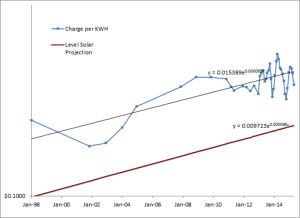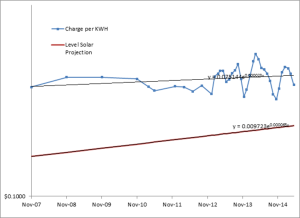“O Sole Mio”, Part 1
So we want to look into going solar, mostly for the environmental benefit. But we also want to avoid a bad financial deal. And it turned out the latter is not easy to do.
First, there is really almost no objective evaluation and comparison on the Internet. When I did searches with various terms, such as “solar panel comparison”, “solar panel installation”, “solar power companies”, etc., combined with “Long Island” or “New York”, the first few pages that Google presented to me are all advertisements on Google, or solar power company websites.
Even more discouraging, Solar City, supposedly the largest solar power company, one of the several companies founded and run by Elon Musk, whose vehicle came over to our next door and installed a system on their roof, decided, through its automated website, that they didn’t serve our area.
Fortunately, there are companies which do. We caught a guy from such a company knocking on doors in the neighborhood, and through him made an appointment with Level Solar. Little did we know the amount of untruths and lies that await us.
Level Solar and Power-Purchase Agreement
Level Solar prides itself as a local company, headquartered in Ronkonkoma, in the middle of Long Island. Its sole business model is power-purchase agreement. Their representative was friendly, and we didn’t have any predisposition for or against any financial arrangement at this point.
The first point of business is to figure out how much electricity we used for the previous year, and for what price. The representative helpfully calculated the answer to the second question from our most recent electricity bill, and came up with $0.22 per KWH.
Level Solar’s current deal is like this: they’d put a Photovoltaic (PV) system on our roof to produce electricity, and we’d be buying the electricity at a “locked in low price”: $0.15 per KWH initially, increasing at 2.4% per year, for 20 years. What if we sell our house, and a prospective buyer doesn’t like the deal? Well, “find other buyers” is the answer. So we’d better make sure that the price we signed up for is going to be below the electricity rate in 20 years!
We were told that while we are currently paying $0.22 per KWH, the electricity rate has been going up at 6% per year. So if we pay Level Solar $0.15 per KWH to begin with, going up at 2.4% per year, we’d get a better and better deal as the years go by. With such happy calculations, we were given a bunch of papers to sign, mostly relating to governments of different levels, but the last of which is the contract. (This is a tried and true sales tactic, I eventually reflected, as once you’re in the habit of signing your signature, one more of those does not make any difference. But I was not in the right mind then.) When we asked about the effective date of the contract, we were told that we needn’t worry. The contract wouldn’t be effective until both parties signed it, and they wouldn’t do that until later, when they come to present their design to us.
After the rep left, my calculations and modeling got underway. Seriously.
The first problem is that we don’t actually pay $0.22 per KWH. While the representative used our bill to get the number, he did it by dividing the total monthly payment by the total KWHs used, even though he helpfully pointed out that there was a “Basic Service” amount that couldn’t be offset by solar installation—this is the per day amount we pay to be connected to the grid! Once we deducted that amount, the same bill yielded slightly less than $0.19 per KWH. The average over the whole year is a little more, but still less than $0.20 per KWH.
I happen to have back electricity bills for the last 17 years. Although they are not for every month, they gave me a long enough time frame, comparable to the 20 years for the power-purchase agreement. Using these, I found that our local utility has been increasing the electricity rate at a compound rate of 2.25% per year, far below the 6% that Level Solar suggested. Furthermore, if we use the last 8 years, the rate is actually pretty stagnant, going up at 0.84% per year. Going forward, the local utility has filed a plan to increase their delivery charge by 4% per year for 3 years, and delivery charge is approximately half the per KWH we pay (the other half being the cost of electricity). This plan is now being debated, and its passing is not certain. So in the next three years, the maximum increase we are facing is about 2% per year, and considering the uncertainty, and that the cost of electricity is actually dropping slightly due to the new technology of fracking, the expected rate increase is less.
Still, using our historical numbers to predict the future, we get that if electricity rate goes up at 2.25% per year (as from our last 17 years’ data), we’ll have less and less savings per year; and if it goes up at the 0.84% per year as from the last 8 years’ data, we’d be paying more for solar in the last two years of the contract than the utility rate!
And then there is one more problem. If their system produces more than the amount we use, either due to their being conservative in their calculations, or due to our using less energy, such as what could happen as our kids leave the house, and we switch to more energy-saving appliances (such as fluorescent and LED lights), we’d still be on the hook to pay the solar company the set rate ($0.15-0.23 per KWH), while the utility would either pay us the bulk purchase rate (currently at about $0.04-0.05 per KWH), or nothing at all (which happens in some parts of the US).
As it turned out, paying a commercial entity to use my roof to generate electricity for others to use is not something I planned on doing.
Now there is only one thing to do: cancel the contract, which supposedly has not come into effect. Our friendly representative told us that we could simply call and tell him that. So we did. But the contract says that to cancel we must fill out a form and mail it to a NY city address, presumably that of Level Solar’s lawyers. So we did that too. Certified.
“O Sole Mio”, Part 1 Read More »











